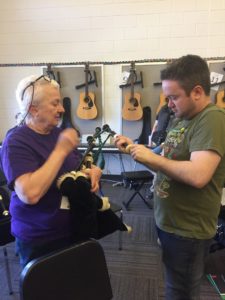 A wee bit of history: Contrary to popular belief, bag and pipe musical instruments probably originated in the Middle East – not in Scotland! It’s believed that Celtic tribes introduced the bagpipe to Scotland (then known as Caledonia) around 1 A.D. Eventually bagpipe music became a vital part of Scottish social and military life. Even in World War II, pipers still accompanied troops into battle. Today, bagpipe music is synonymous with Scottish culture.
A wee bit of history: Contrary to popular belief, bag and pipe musical instruments probably originated in the Middle East – not in Scotland! It’s believed that Celtic tribes introduced the bagpipe to Scotland (then known as Caledonia) around 1 A.D. Eventually bagpipe music became a vital part of Scottish social and military life. Even in World War II, pipers still accompanied troops into battle. Today, bagpipe music is synonymous with Scottish culture.
The highland bagpipe has pipes containing reeds that are actuated by air pressure from a windbag to which all pipes are attached. The melody is played on one pipe called the chanter which has finger holes. Chanters have a melodic range limited to nine notes.
The other three pipes are called drones; they rest on the shoulder, sounding one sustained tone each and furnish the accompaniment. In modern instruments, the pipes are inserted into stocks that are permanently fixed into the bag. In the Scottish highland pipes air is supplied by the player blowing into a tube connected to the bag. In others, such as the small pipes, Irish pipes and French musette, the air is supplied by bellows which placed under the arm of the player, who regulates air into the bag.
In early Eastern instruments, both the chanter and the drone pipes have single reeds; in some modern types, all the pipes have double reeds, as with those used in Italy and parts of France. In the pipes of Ireland, Scotland, and Brittany the drones have single reeds and the chanter has a double reed.
Historically, bags were made from animal skins. Modern bags are cut from leather, rubber or synthetic material called Goretex.
The pipes were originally made of bone or ivory, today they are normally made of hardwood or plastic.
Bagpipe music falls into two basic types; Ceol Mor,(Koll-more) the classical “great music,” or Piobreachd and Ceol Beag,(Koll-bek) “little-music” such as marches, dances and slow airs. As in other pipe bands today, the repertoire of the St. Andrews Pipeband of Vermont is from Ceol Beag.
Whether it’s Ceol Mor or Ceol Beag, this ancient music is as delightful today as it surely was centuries ago.
